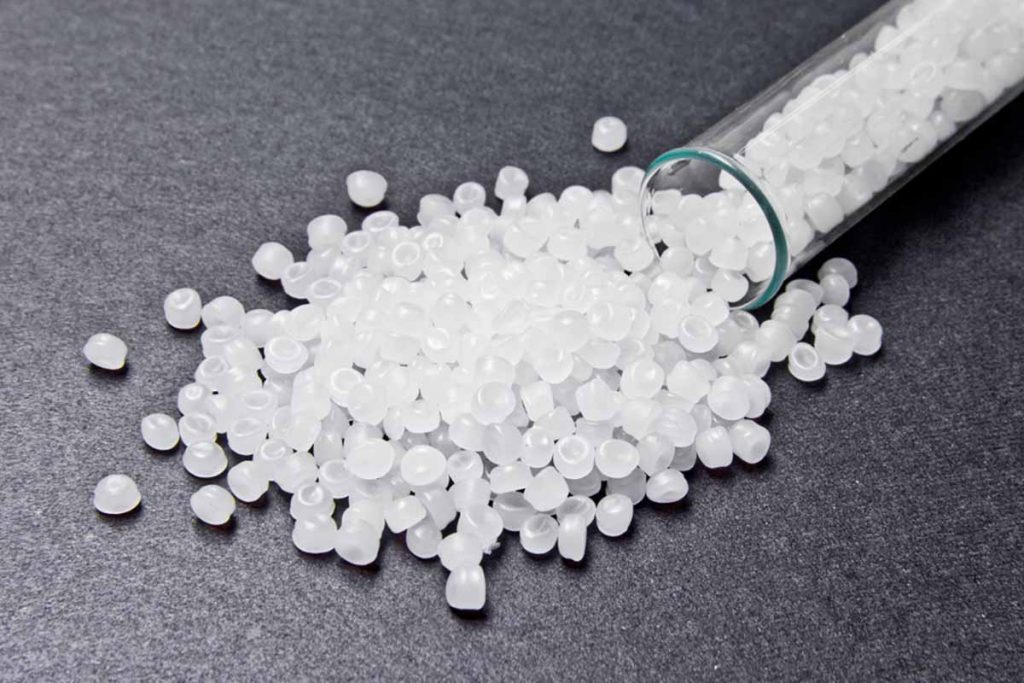
The long-term outlook for used milk jugs contributed to KW Plastics’ move to add white recycled HDPE resin to its offerings. | StanislauV/Shutterstock
Recycled resin producer KW Plastics is rolling out white HDPE pellets this month, an idea that isn’t new but is gaining traction due to changes in consumer behavior and increasing demand for PCR.
KW had considered pursuing a white option for almost 10 years, but it wasn’t until fall 2023 that sufficient interest materialized to invest in new capacity, said Scott Saunders, general manager of KW’s plastics recycling division.
Equally important was the sense that, in the long term, supply of natural HDPE bales would tighten and create an opportunity for colorable resins. Recycled natural HDPE is in high demand for its food-use applications, primarily milk jugs, but also is desirable for applications that require colors beyond gray or black.
Despite price crashes that have occurred about every two years, HDPE natural bales remain the most valuable commodity among post-consumer plastics. In November, natural bales were at an average of 49.63 cents per pound, according to Recyclingmarkets.net data, but peaked at 108.44 in September 2021.
In comparison, since 2018 average curbside PET bales have peaked at 39.56 cents per pound and color HDPE bales at 58.13.
The white resin is priced at a substantial discount to recycled natural resin, Saunders said, and while that spread varies with market pricing, it currently is around 30 cents cheaper per pound. Recycled resin pricing typically correlates with post-consumer bale market movements.
As with any commodity, post-consumer bales reflect basic supply-and-demand principles — low supply and high demand support prices. And consumer habits have affected post-consumer bale supply, as overall milk consumption has fallen, non-dairy options are taking increasing market share, and premium and organic milks favor PET or glass packaging.
Milk consumption trends
Overall dairy consumption has declined in the U.S. over the past 50-plus years, with annual pounds per person of milk dropping from 196 in 2000 to 130 in 2022, or 34%, according to data from the USDA Economic Research Service. In more concrete terms, that translates to less than half a cup per day consumed per person in 2019 — a drop of 50% from 1970.
And although many participants in natural HDPE bale markets blame rising popularity of plant-based milks for lower milk-jug supply, the ERS found that the increase in sales of plant-based milk alternatives was much smaller than the decrease in sales of dairy milk and likely aren’t a primary driver of those trends.
“Compared with each of the previous six decades, U.S. daily per person fluid milk consumption fell at its fastest rate in the 2010s,” according to a June 2022 article by the ERS.
Correlating with this, total U.S. dairy milk sales ranged between 50 trillion and 55 trillion pounds per year from 1975 through 2014, but started dropping in 2015, reaching 42.283 trillion pounds in 2023, a decline of 15% in that time period.
Timing is everything
For years KW discussed adding white resin to its offerings, Saunders said: “There was always talk from the brands and from the blow molders that they wanted a lower-cost solution than the natural, but there was really not a lot of push or commitment.”
The company has installed 30 million pounds of annual resin capacity, he said, and expects it to be used domestically in packaging and extrusion applications such as blowmolded bottles, white pails of varying sizes and light-colored films.
“We initially looked at doing a full-color sort, but the more colors that you sort, the cost really goes up dramatically because of all the other equipment needed for silo storage and this and that,” Saunders said. KW decided on white, with other color bales going into dark or black resin.
As a result, “we decided that we would really take a look at the options for sorting lighter materials out of the mixed-color stream,” Saunders said. The amount of white packaging in a color HDPE bale varies from 27% to 42%, “depending upon what’s on sale and what’s being pushed in that local market.”
After purchasing the sorters in November 2023, KW expected to have them running by March 2024, but the equipment wasn’t put together until October, he said.
With installation of the new equipment, KW included electrical and air infrastructure to handle three more sorters, to eventually either sort the cap and ring out of natural or to sort more white material out of mixed color bales, he said.
Saunders said buying interest is strong: “A lot of it is from people that said they had no interest in the material a year ago when we first mentioned it,” and KW has received purchase orders for sample resin and expects to start shipping truckloads by the end of November.

